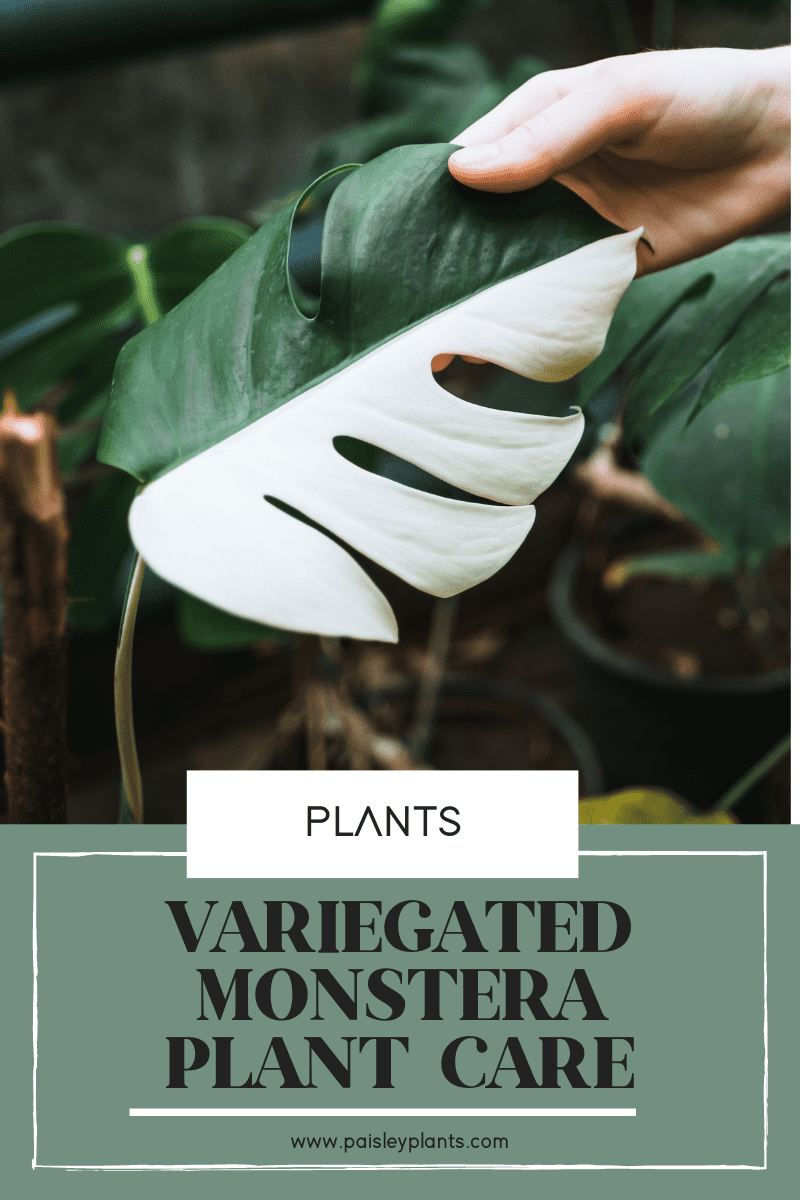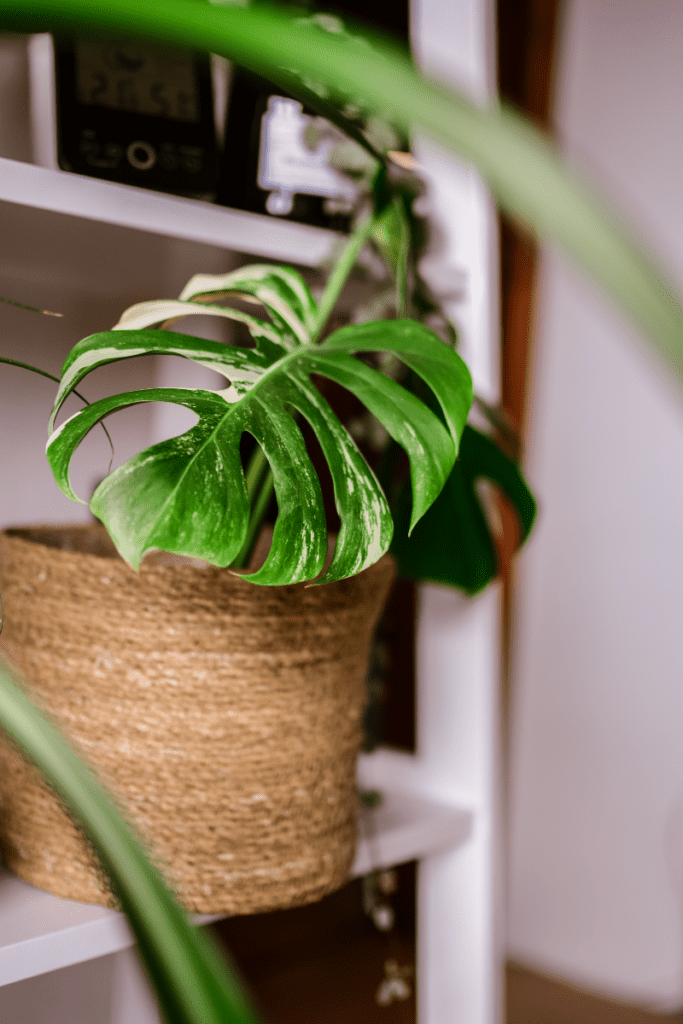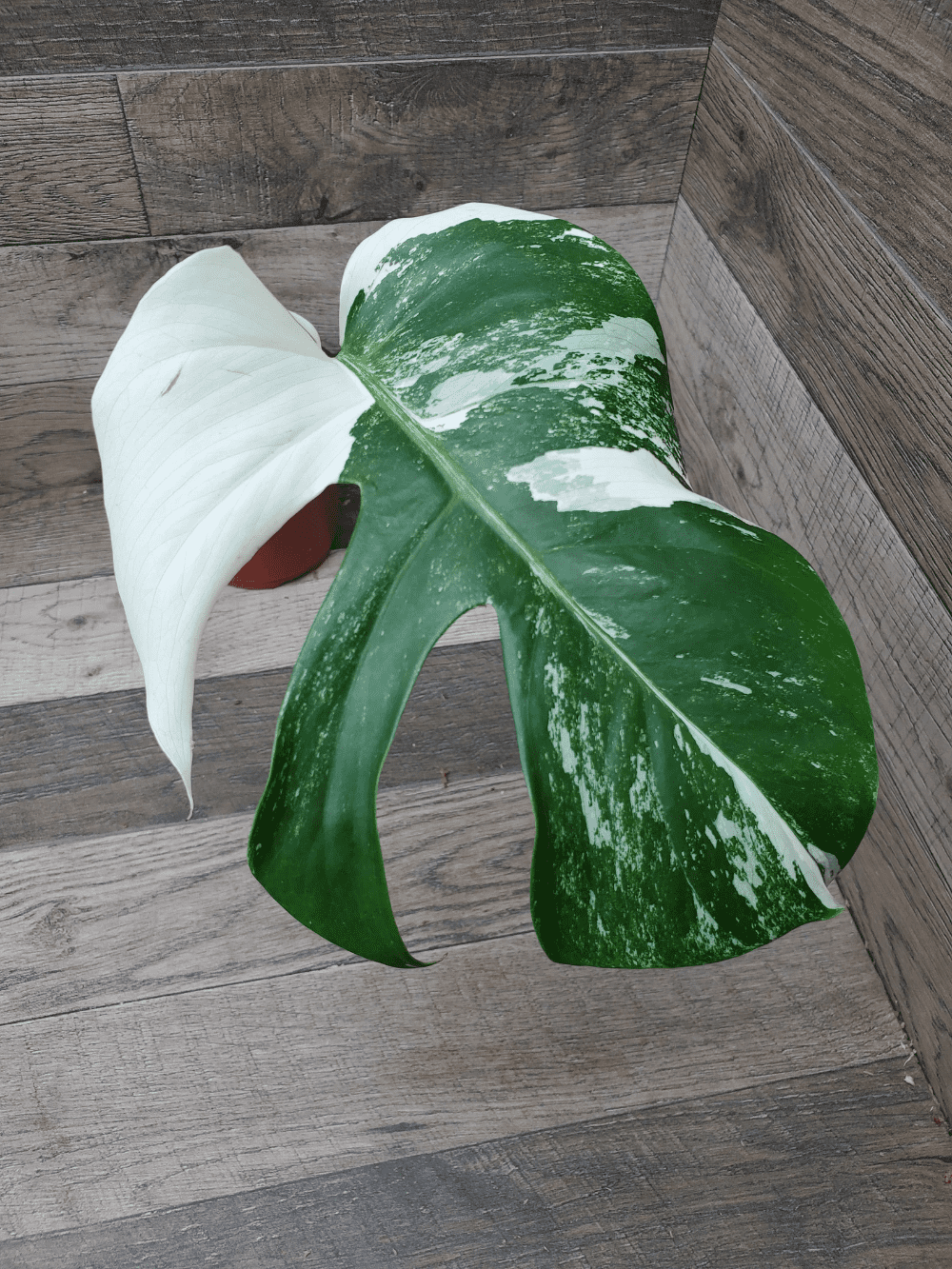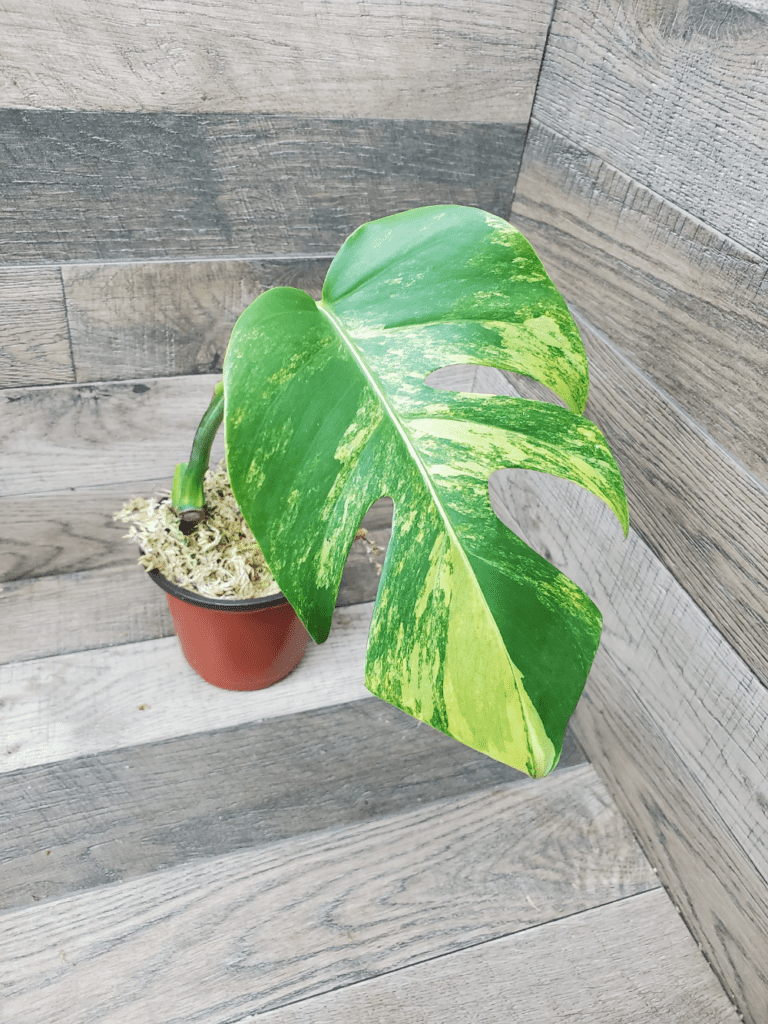Variegated monsteras are a stunning and rare group of houseplants that are sure to turn the heads of every single one of your houseguests (trust us!). In this post, read on to see in-depth information on how to care for a variegated monstera, as well as where to find one of your own.
Table of Contents
Variegated Monstera Background and History

This post includes affiliate links.
What is a “Variegated Monstera?”
A “variegated monstera” is an umbrella term, and refers to wide range of Monstera deliciosa variations. Each one is technically the same species, but the variegations separates each deliciosa.
The Monstera deliciosa, otherwise known as the Swiss-cheese plant or the split-leaf philodendron, is one of the most identifiable members of the Monstera genus. They are a climbing evergreen plant that is native to Central America and easy to spot with their unique leaf pattern.
Typically, the Monstera deliciosa has solid green leaves. However, on rare occasions, the Monstera deliciosa may develop multicolored splotches of color on the leaves that greatly differs from the norm. These differences in color on the deliciosa leaves is variegation.
What is Variegation?

When a plant is variegated, it means that the plant contains differently colored foliage in either the stems or the leaf of the plant. This is caused by a lack of chlorophyll in some of the plants’ cells, which results in splotches on the plant (commonly white, yellow, or even pink).
Variegation is not a detriment to the plant’s health at all, though the deficiency in chlorophyll causes these monsteras to grow slower than the standard variety of deliciosa.
Variegated Monstera Varieties
The most common of the variegated monstera varieties are:
1. Monstera deliciosa “Thai Constellation”

Image via The Plant Farm (on etsy)
This is by far the most common of the variegated plants, and the one that you will most likely encounter in many plant nurseries. True to their name, the Thai Constellation monstera has white and pale yellow variegations that strongly resemble that of a galaxy.
Check out our full guide for the Thai Constellation here!
2. Monstera deliciosa Albo Borsigiana

Image via MyVariegatedJungle (on etsy)
Another highly popular variety in the variegated plant family is the Monstera deliciosa Albo Borsigiana is identifiable by its blockier white variegations.
In addition, the leaves of the Variegated Monstera Albo grow smaller, making it more compact than the traditional Variegated Monstera deliciosa.
3. Monstera deliciosa “Aurea” or “Marmorata”

Image via MyVariegatedJungle
Just like the Albo Borsigiana, the Aurea monstera is also a compact plant. In addition, their leaf variation is splotchy and yellow.
4. Monstera deliciosa “Mint

Image via JaciPlants
This is one of the newest (and rarest) plant. They are identifiable by its marbled mint-green and white leaves.
Despite their differences in leaf variegation, each has a very similar set of growing conditions. Let’s take a further look at the plant’s preferred growing conditions in the next section:
Monstera Plant Growing Preferences
Sun and Light
The best light conditions for variegated monstera plants is bright, indirect light. For many of these plants, the intensity of their variegation is dependent on the amount of light they receive.
Lower light conditions may cause your plant to produce more chlorophyll to compensate for a lack of light. This causes the leaves on the plant to revert to green.
Be especially careful with exposing your plant and its leaves to too much direct sunlight. Direct sunlight can burn the delicate leaves of the monstera plant.
Soil Type
The ideal type of soil for a variegated monstera plant is one that is both well-draining, yet still able to retain enough moisture to nourish the plant. We recommend for these houseplants selecting an aroid potting mixture that contains materials such as charcoal, pumice, peat moss, and orchid bark, to name a few.
Water Schedule for Monstera Plants
This plant prefers a soil that is moist, but not waterlogged. A good rule of thumb when watering these plants is to wait until the soil has mostly dried up; this roughly equates to watering the plant once per week in order to reveal the beautiful variegated leaves.
Fertilizer
Fertilizing your plant is helpful in encouraging vigorous plant growth. You should only add fertilizer your plant in the spring and summer, and completely cease all fertilization during the fall and winter.
Select a liquid fertilizer with a balanced NPK ratio of 20-20-20. Dilute this fertilizer to half strength and add it to your gardening routine once a month.
Temperature and Humidity for Monstera Plants
The ideal temperature range is somewhere between 65° to 80° F. We highly advise against keeping your plant any place where the temperature can dip below 50° F; avoid places such as near air conditioning vents or drafty windows.
As for humidity, the monstera is forgiving of most household humidity conditions. Ideally, the humidity level should be at least 50%. If you are worried that your home might be too dry for your monstera, then we recommend placing a humidifier in the same vicinity as your plant.
Selecting a Container and Repotting
The most important aspect of selecting a container for this plant is drainage. Choosing a plant pot with multiple drainage holes will help excess moisture escape the container, which allows your soil to be comfortably moist, but not waterlogged.
When your plant becomes root bound (roots growing out from drainage holes, stagnant growth), it is time to repot your plant. Size up your monster’s pot gradually; select a planter that is 2 to 3 inches larger than the previous one.
How to Buy Variegated Monstera Plants
So, you’re probably wondering where you can find a plant like this for yourself. Due to their immense beauty, variegated monsteras are in high demand. Unfortunately, variegated monsteras are considered a rare plant, therefore the supply is very low.
With high demand and low supply, it can be easy to be scammed by so-called “plant breeders” who claim to have these variegated plants. Keep in mind that most of these variegated cultivars are impossible to grow from seeds. When you’re online and see adverts for seeds, save your time, energy, money and do not fall for that scam.
Because it is so difficult to mass-breed these plants, it’s highly unlikely that you’ll find this in the garden center of your local corporate store or flower delivery services. If you’re at a big chain store and happen to stumble upon a variegated monstera – consider yourself very lucky!
Therefore, your best bet at finding a variegated monstera would be at either a local exotic plant nursery or an online seller (like etsy). Local plant nurseries can be incredibly helpful in your pursuit. However, they are also one of the most expensive options out there and you may find yourself paying top-dollar for a variegated monstera.
Online sellers undoubtedly have the most variety when it comes to variegated monsteras. You can opt to buy a fully established mature monstera variegation, a stem cutting to propagate, or you may even stumble upon a baby monstera. Searching online will give you the widest range of options compared to in-person shopping.
Online retailers can also be cheaper, though we always recommend being cautious when placing an order online. Remember – if a deal is too good to be true, it probably is! Don’t let your desire for these plants allow you to be scammed by less-than-truthful “plant sellers.”
Where to Buy
Variegated Monstera Plant FAQ
Yes…but it is extremely unlikely. With repeated propagation, you can hit the lottery and propagate a variegated monstera to add to your houseplants. Though, we must warn you, it may take a lot of tries before you get a variegated monstera. The odds of a randomly variegated monstera are 1 in 100,00. If you have the patience for propagating 100,000 monstera clippings, then go for it! Otherwise, we suggest pressing your luck on finding a plant seller.
The biggest factors that makes the variegated monstera so expensive is quite simple: supply and demand. It is no secret that the variegated leaves of these monsteras make them extremely popular amongst plant collectors.
The downside to all this is that variegation is a very rare occurrence in these houseplants. As we’ve said previously, 1 in 100,000 monsteras come out variegated. Not only that, but due to their lack of chlorophyll, variegated monsteras grow at a slower pace than their non-variegated counterparts.
For these reasons, it is incredibly difficult to mass-produce variegated monsteras in order to meet the high demand.
This depends on the size of the variegated monstera that you are looking for. First and foremost, when you go to shop for one, be ready to pay a pretty penny for any form of variegated monstera. Even the price of a variegated monstera cutting are listed on Etsy from as low as $60 USD to as much as $200 USD plus shipping.
If you’re really willing to pay top-dollar (and if you can find it), you can purchase a mature plant for anywhere from as low as $500 USD to a hefty price of $5,000 USD.
There are a few different variegated varieties, of which the Monstera Deliciosa ‘Albo-Variegata’ is the most striking one. But they are very rare and quite expensive. Beginning of 2020 a Swiss cheese plant sparked an online bidding war as a botanist spends thousands on it.
Conclusion
If you can get your hands on one of these rare beauties, then we highly suggest you do. While caring for these plants involves a great deal of patience, it is absolutely worth it to have this iconic plant to spruce up your home or garden and you’ll soon realize why it’s one of the favorites amongst plant owners!
Want more plant fun? Head to one of these plant posts!

